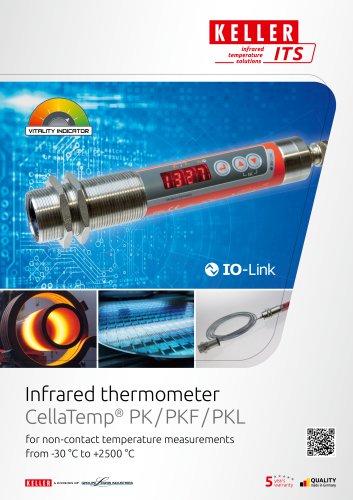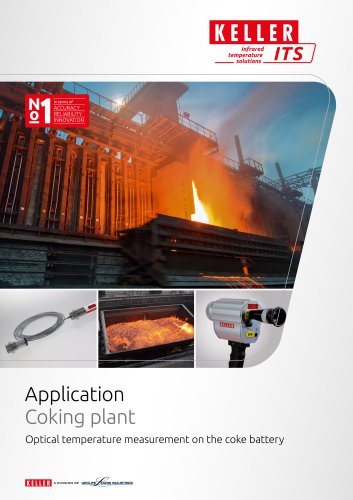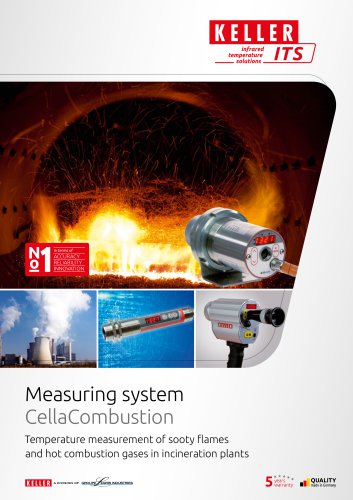 Website:
Keller ITS (Infrared Temperature Solutions)
Website:
Keller ITS (Infrared Temperature Solutions)
Grupo: Legris Industries
Excertos do catálogo

TECHNICAL REPORTS Precise non-contact temperature measurements of shiny metals by Albert Book The measurement of shiny metals at low Physical principles temperatures is still a challenging measuring A pyrometer captures the heat respectively infrared radi- task in the field of non-contact temperature ation emitted from the measuring object and determines the measurements due to the very low thermal radiation and the varying radiation properties of metals. temperature from these values using the Planck's law. The radiation level not only depends on the temperature but also to a large extent on the emissivity of the measured object. The emissivity is a relative quantity; it is a result of the ratio of the radiation energy of a real body and of an ideal body or so-called The following article describes the physical principles, different methods of measurement, state-of-the-art technical develop- "black body". For non-transparent objects the relation between the emissivity ε and the reflection factor ρ is ε + ρ = 1. Good heat emitters with a high emission capability have a low reflectivity and vice versa. In general, all non-transparent non-metals ments and the basic conditions necessary have a high emissivity of > 80 %. Therefore, non-metallic meas- uring objects cause less problems when their temperature is measured without contact. Metals, however, have very different emissivities from < 10 % for high polished metals up to > 80 % for oxidised, coated or red-hot metals. The emissivity can also change with the temperature and it is dependent on the wavelength of the radiation. It increases with shorter wavelengths (Fig. 1). Fig. 1 The emissivity of metals decreases with an increasing waveleng
Abrir o catálogo na página 1
TECHNICAL REPORTS method. This means that a disc is rotating in front of the sensor. The disc has a reflecting surface and an opening. When the disc is rotating, the sensor alternately captures the object radiation through the opening and the reflected internal radiation of a reference surface with a known temperature. When components are continuously rotating in a measuring device the question arises as to the work life and the main- tenance that will be necessary, particularly when the devices operate in a rough industrial production area with high ambient Fig. 2 Wien's displacement law –...
Abrir o catálogo na página 2
TECHNICAL REPORTS A larger lens at the pyrometer would considerably increase the amount of radiation received. However, this would require high-quality precision lenses to keep the optical aberration at a low level. Instead, a number of these devices are equipped with a simple fixed-focus lens operating with a short focal distance. To reduce optical measuring errors, the devices would have to be installed exactly at the specified focal distance f for small targets. Even when the measuring distance only deviates from the focal point by a couple of millimetres, the diameter of the measurement...
Abrir o catálogo na página 3
TECHNICAL REPORTS Pyrometer with high quality optics Pyrometer with simple optics Ratio between diameter of the object and the measuring field size Bow with a Teflon tape to measure shiny rollers. Changing temperature readings when the object size changes. A further method to measure temperatures of shiny metal roll- A highly luminous optical system with a large entrance aper- ers is an indirect pyrometric method which uses an emissivity ture is again associated with lower field depth. To avoid reading enhancer. For this purpose, a Teflon tape on an elastic bow is errors caused by a blurred...
Abrir o catálogo na página 4
TECHNICAL REPORTS General requirements for measuring low temperatures at metallic objects emits a percentage of interfering radiation in the infrared range of the pyrometer. Very often it is therefore unavoidable to use a sight tube. However, a simple sight tube is only suitable to a limited degree as the tube itself can act as a radiation source. A direct measurement underlies the restriction that the object The sight tube must be cooler than the measuring object and it temperature must be at least 25 °C above the internal device must consist of a low-radiating material such as stainless...
Abrir o catálogo na página 5Todos os catálogos e folhetos técnicos Keller ITS (Infrared Temperature Solutions)
-
AN CellaAsphalt_ID2523_201504_en
4 Páginas
-
AN Concrete Mixers_ID2522_201606_en
4 Páginas
-
BR CellaTemp PX_ID2007_202312_en
20 Páginas
-
BR CellaTemp PA_ID2004_202403_en
20 Páginas
-
BR CellaTemp PK PKF PKL_ID2005_202411_en
16 Páginas
-
AN Coking plant_ID2538_202407_en
4 Páginas
-
AN CellaCombustion_ID2520_202411_en
4 Páginas
-
KITS App - Digital Service
6 Páginas
-
AN Aluminium_ID2521_202208_en
4 Páginas
-
AN Roller stand_ID2530_202203_en
4 Páginas
-
AN Furnace_ID2529_202201_en
4 Páginas
-
AN_Bar mill_ID2533_202202_en
4 Páginas
-
AN CellaWire_ID2531_202110_en
4 Páginas
-
Software CellaView
8 Páginas
-
High-tech solutions from tradition
20 Páginas
-
BR CellaCast PA83 PT183_201811_en
12 Páginas
-
BR CellaPort PT_201905_en
16 Páginas
-
AN CellaCast_201811_en
8 Páginas
-
Flyer IO-Link_201810_en
2 Páginas
-
TR Induction heating_201303_en
6 Páginas
-
TR Panorama-Pyrometer_201508_de
5 Páginas
-
TR Emissivity_201604_en
4 Páginas
-
TR Metrological Errors_201604_en
3 Páginas
-
TR IO-Link_201610_en
7 Páginas
-
BR Mikro PV 11_201512_en
4 Páginas
-
TR Optical Influences_201609_en
4 Páginas
-
TR Two-colour pyrometer_201507_en
8 Páginas
-
AN CellaInduction_201604_en
4 Páginas
-
AN Glued laminated timber_201606_en
4 Páginas
-
AN Metal sheets_201608_en
4 Páginas
-
AN Measurement of small objects
4 Páginas




































